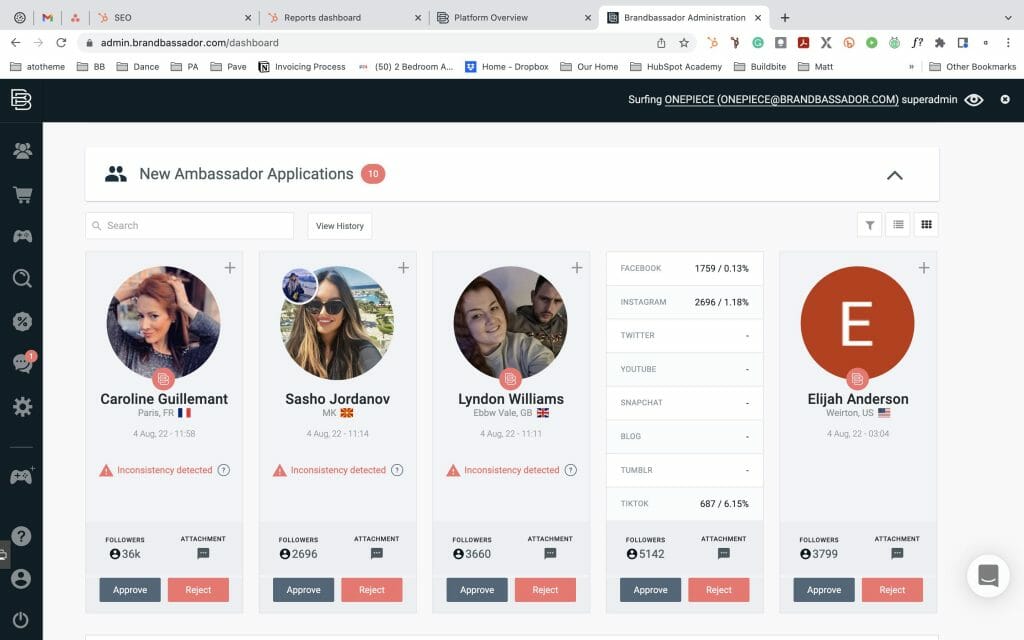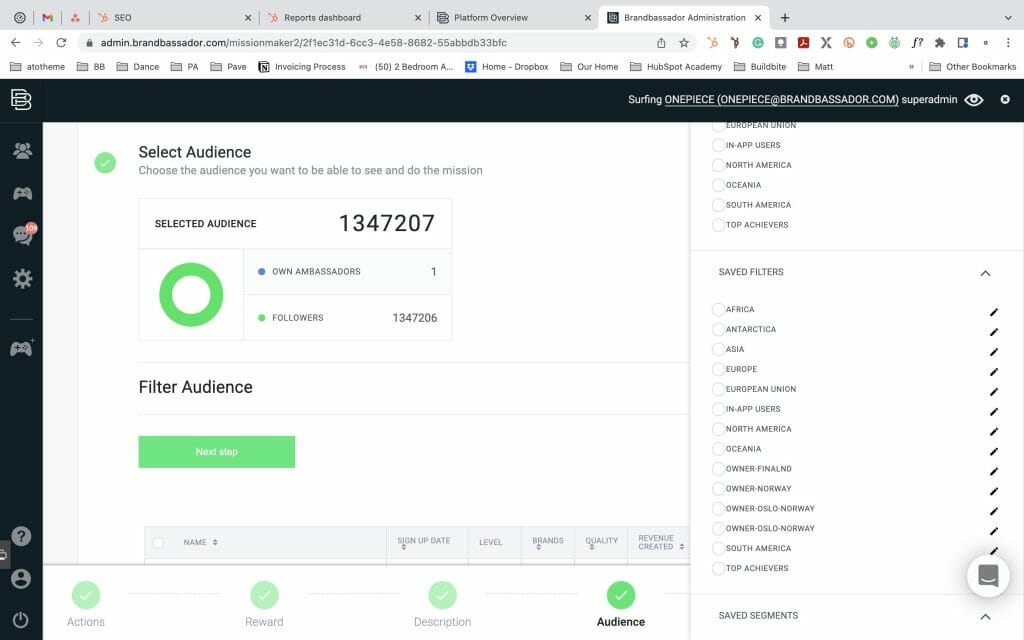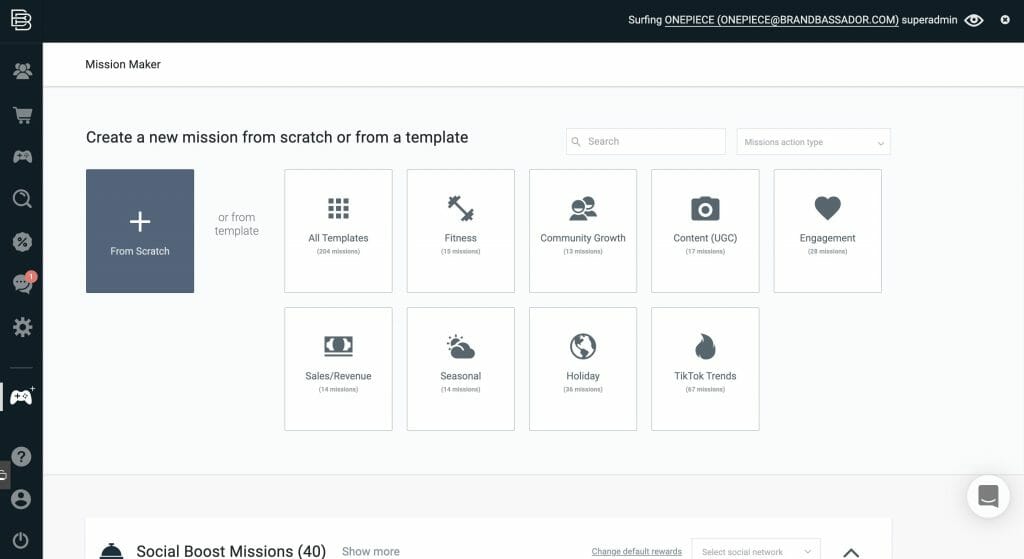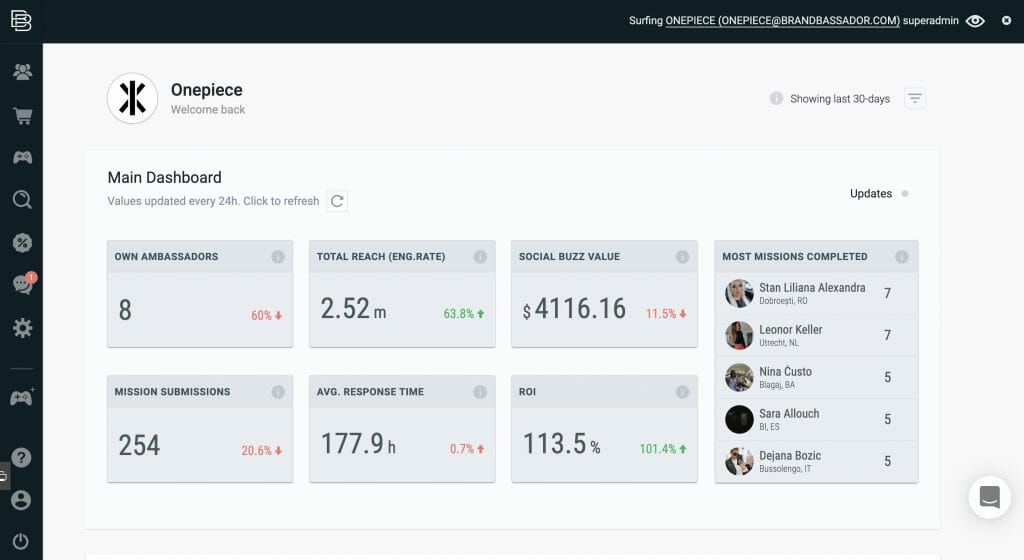
We’ve seen quite a few influencer platforms here—beyond the reviews that we publish is a whole group of software that wasn’t good enough to even bother commenting on—and we were starting to feel like we’d heard all the possible permutations of an origin story. Brandbassador’s a new one for us. It shares its theme with others we’ve heard: a company starts up with an unrelated product, then pivots to influencer marketing after they had to build their own internal tools to effectively market their new product.
But Brandbassador differs in a couple of ways. First, whenever we hear these stories we wonder what happened to the original product. For some reason, those get thrown to the side after the IM platform is developed. Second, the pivot is usually somewhat logical, like the original idea is software or social media related. Brandbassador bucks both these trends by having its original product continue to succeed.
Yes, Brandbassador started its life in the offices of the apparel company Onepiece, a company that found quick success with its unique product by focusing its marketing strategy on social media and big-reach influencers. But that early success morphed into a late-stage stall out, as competing companies flooded the market (and Instagram). It became increasingly difficult and costly to acquire new customers, and the Onepiece braintrust tried to dream up new ways to grow. By this point, everyone and their uncle was hiring Kardashian-like influencers to peddle their wares, so much so that even landing micro- and nano influencers was becoming more competitive.
Someone must have remembered that old bit of wisdom regarding how much less it costs to retain existing customers than it does to find new ones. This was the genesis of Brandbassador, a product that mixes the best parts of two different strategies: influencer and affiliate marketing. The platform the company built sounds like affiliate marketing software: incentivize your customers to refer friends and families and they get rewarded. And, at its most basic, that’s what Brandbassador does.
But what happens when the incentive programs you create involve your customers creating content on your behalf to drive sales? Magic, apparently. Onepiece is still going strong, and so is Brandbassador (which is, ironically, now a separate company). Both businesses continue to delight their existing customers and acquire new ones. Read on to see how it works.
Summary:
Pricing
Brandbassador offers both self-service options and a fully managed one. Note that with the self-service option you still get some help from their team, and with the fully managed service you still get to log in to the software to see what’s what. Pricing isn’t publicized, but we can tell you what we do know. Plans are billed either monthly or annually (your choice), and include features as follows:
- Growth — Unlimited ambassadors, unlimited admin users, unlimited "missions," custom filters, automated & bulk messaging, app (and in-app support) for ambassadors
- Pro — All of the above, plus: premium onboarding, dedicated success manager, bi-weekly coaching (includes community performance analysis, "outcome optimization" discussion, and "growth support")
- Elite — All of the above, plus: custom success plan with benchmarking, bi-annual business reviews, monthly trends consultation, full management of ambassador program, priority support
The Details
As we mentioned in the overview, Brandbassador works like a hybrid of influencer and affiliate marketing. You won’t find macro-influencers on the platform, for two reasons. First, macro-influencers are known to be a pretty ineffective use of social media—their communities are too large to facilitate any authentic engagement. More to the point, though, Brandbassador doesn’t necessarily work off of a traditional search/discovery module. The platform does have a way to search through its massive database of social profiles, but ultimately its power is in helping you find influencers from your existing pool of customers.

The idea here is to let influencers come to you by creating a landing page with an application for participation. How you get people there is up to you—post the link to social media, or recruit right from your checkout page, stick a link in the footer of your website, solicit for ambassadors in your marketing newsletters, the options are plentiful. The important thing is you’re connecting with people who are already into your brand.
Applications are viewable from the dashboard, and going through them couldn’t be easier. The UX design here is a standout, as you can find out quite a lot about your applicants without ever leaving the page you’re on inside Brandbassador. You’ll see their profile pic, location, and follower total (and also the channel where they found out about your ambassador program) as a high-level summary. If you click on their follower totals, it brings up an overlay that breaks down the count for each channel. If you click on their profile pic, an overlay of their content appears, which you can scroll through to make sure their aesthetic aligns with yours. From there, you can approve or reject an applicant, as well as segment them into one or more groups you’ve created.

Normally, we’d like to see more insights here, especially around the audience. Psychographics and fraud detection are big deals at this stage of selecting an influencer, but we’re also not bothered that these weren’t included here. That’s because this isn’t traditional influencer marketing; you’re not striking individual deals with personalities. You’re not exchanging cash for content, you’re incentivizing your customers to refer their friends, family, and followers. Brandbassador doesn’t even call its campaigns “campaigns.” Instead, they’re called “missions,” and this is more than a semantic distinction.
Missions are about more than just getting social media users to post content about your brand. They’re a way to gamify engagement. You can reward your ambassadors for driving sales, of course (and a cool feature here is that they can create their own custom tracking links). But there’s still much more that you can do. Need some quick market research? Create a survey and create a mission rewarding them for answering the questions. Need user-generated content for your own social accounts? Make a mission that has ambassadors creating and uploading content directly to you instead of posting on their social accounts. Want them to leave a review? Make a mission. The possibilities with these are endless.

Missions are created on the platform website itself, but for your ambassadors, the experience is purely mobile. They’ll interact with you through an app that has all your missions listed, but they’ll only see the ones that you’ve decided they can see. They can scroll through, choose which ones they want to do, and then upload their content/register their actions all within the app.
From there, it’s just a matter of checking in with the progress of all these missions and looking into how each is performing. The performance analysis is very nuts-and-bolts, focusing on the tangible aspects of each mission. By this, we mean that standard influencer metrics—likes and comments—are offered alongside the data on how much money you’ve spent and how much money you’ve earned. For example, if you click into your total sales, you’ll get to see—through an integration with your e-commerce platform—how much each ambassador earned for you (and how much commission you owe them) for a very concrete idea of the return you’re getting. All of this is exportable into a CSV file, which might be one of the few true disappointments of the platform. CSV is a great format for importing into another platform but if you just want to share a copy of what you’re looking at a PDF would have been a nice option.


What’s amazing about this is your ability to see how much your Brandbassador programs grow over time. Recall from the pricing section Brandbassador requires a minimum 12 month commitment when you sign on, but that’s just as much for your own good as theirs. A program like this takes time to grow—but that doesn’t mean it’ll take much of your time to manage. Once you’re set up with your initial batch of missions and you’ve got everything in place to recruit your ambassadors, Brandbassador’s best practices only require an hour out of each day to manage what’s going on inside the platform. Most of the work is going on behind the scenes—from recruiting to activating to executing—without your intervention. If you’re doing it right, then at a certain point you’ll find you need to use the internal search tool just to find people in your own huge database of already-active ambassadors. And you’ll also see an accounting of every penny you’ve spent vs the pennies you’ve earned (and the value of the social buzz that’s created around your brand). Numbers don’t lie, and they’ll likely encourage you to sign on for another year.
Conclusion
Brandbassador does things very differently than most influencer platforms. It’s different enough that the answer to one of the questions in their FAQ—”Is Brandbassador an influencer platform?”—is “Not exactly.”
Not identifying as an influencer platform is one of the many smart things the company’s done. It relies on social influence to drive awareness and sales, but it skirts the standard methods of influencer marketing in favor of something more sales driven. If we had to label it, we’d call it performance marketing—outside of the software costs, you’re only paying out when your ambassadors succeed at their missions. It’s all pretty ingenious, but it’s built out in such a way that it feels dead simple. That’s pretty much the ultimate achievement for an app. Who knew leisurewear was a gateway to software?
Rating
-
Features
-
Ease of Use
-
Reporting
